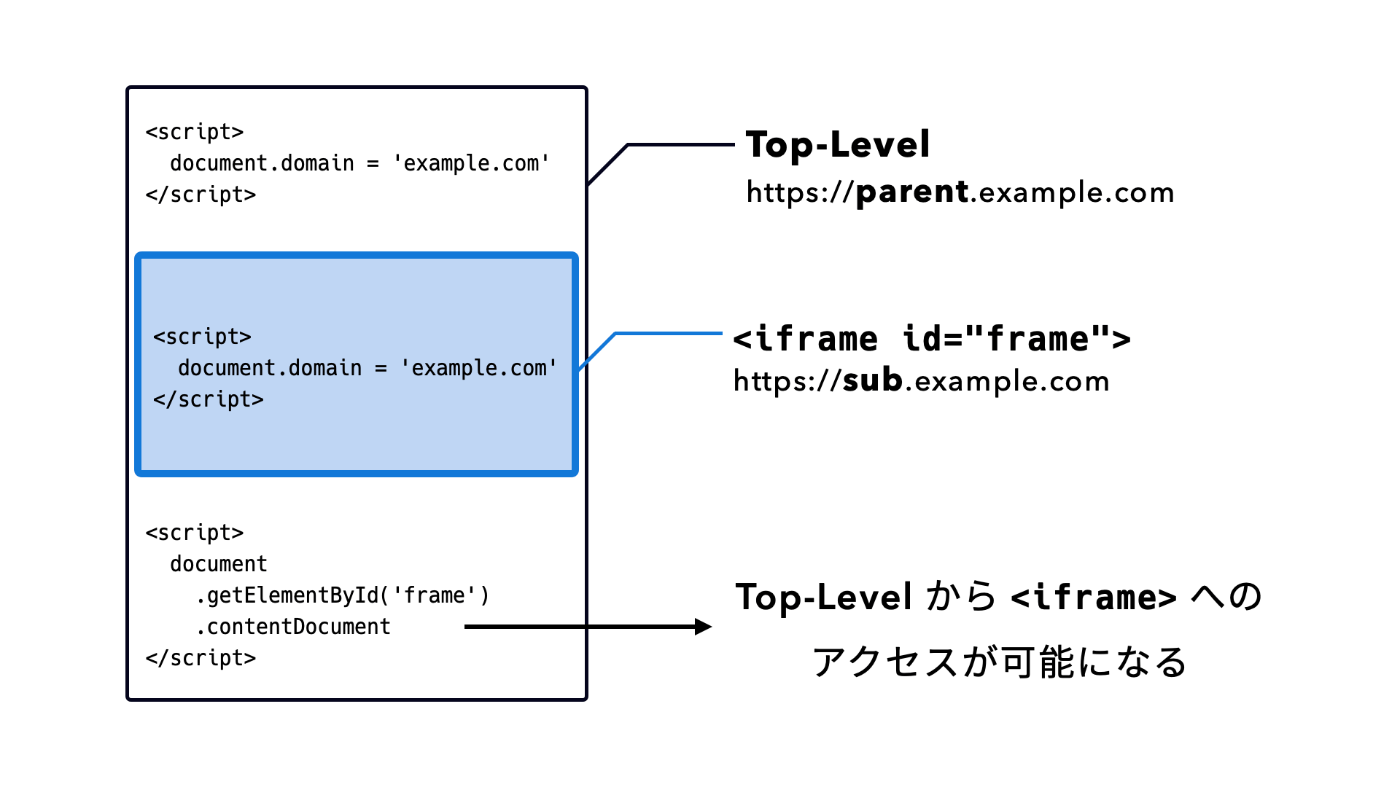Deprecating document.domain setter
document.domain は Document の Origin から domain の部分を参照できる property です。
この値を書き換えることで Same-Origin Policy を緩和することができますが、この機能は非推奨となっています。
そして、この機能はセキュリティや Cross-Origin Isolation の問題から利用できなくなることが計画されています。
本記事では、 document.domain の書き換えができなくなる理由についてまとめます。
document.domain setter
document.domain setter の MDN を参照してみましょう。
The setter for this property can be used to change a page's origin, and thus modify how certain security checks are performed. It can only be set to the same or a parent domain.
document.domain を変更することで Same-Origin Policy を緩和できます。
document.domain にセットできる値はサイト自体の domain から eTLD + 1[1] までの親 domain までです。
例えば a.b.example.com の document.domain にセットできる値は、 'a.b.example.com', 'b.example.com', 'example.com' となります。
緩和の詳細については HTML Standard に記載がありました。
Can be set to a value that removes subdomains, to change the origin's domain to allow pages on other subdomains of the same domain (if they do the same thing) to access each other. This enables pages on different hosts of a domain to synchronously access each other's DOMs.
サブドメインを外すことで Top-Level と iframe 間での DOM へのアクセスが可能となります。

なぜ書き換えができなくなるのか?
document.domain setter の利用ができなくなる理由は大きく分けて 2 つあります。
Same-Origin Policy についての問題
Same-Origin Policy が緩められるというのは Security 的に問題があります。
Avoid using the document.domain setter. It undermines the security protections provided by the same-origin policy. This is especially acute when using shared hosting;
HTML Standard より引用
例えば自分と第三者が example.com の subdomain 上で任意のサイトをホストできるような状況を考えてみましょう。
自分のサイト上 (my.example.com) で document.domain = 'example.com' を実行している場合、他の domain (ex. evil.example.com) から Same-Origin Policy を緩和して my.example.com の DOM にアクセスできます。
これにより異なる subdomain を持つサイトから DOM に対する read / write が可能となってしまいます。
Cross-Origin Isolation についての問題
document.domain setter による挙動を実現するために、同一 Tab 上の Same-Site の frame (Top-Level, <iframe> など) は同一 process 上に配置されます。
Within a single browser tab, frames from different sites are always in different render processes from each other, but frames from the same site are always in the same render process.
Overview of the RenderingNG architecture - Chrome Developers より引用
Setting the document.domain accessor allows pages (within a site, e.g. user1.example.com and user2.example.com) access to each other. To implement this access, the data from those origins needs to be in the same process.
これにより Spectre などの side channel 攻撃に脆弱になってしまいます。
また、 document.domain setter は process を分離するための障壁となっています。
The
document.domainsetter allows developers to relax the same-origin policy, complicating the fundamental security boundary we aim to maintain, and putting roadblocks in the way of post-Spectre changes to Chromium's process model.Deprecate the
document.domainsetter. - Chrome Platform Status より引用
そこで document.domain setter の利用を非推奨とすることで Cross-Origin Isolation を推し進められるようになります。
代替案
上記の理由から document.domain setter は利用できなくなることになりました。
Chrome 101 からはデフォルトで document.domain が変更できないようになる予定です。
postMessage() と Channel Message API
document.domain setter を置き換える方法として、 window.postMessage() か Channel Messaging API があります。
これらの API を使うことで Cross-Origin 間の通信を実現することができます。
詳しい使い方については以下のサイトにて説明されています。
Origin-Agent-Cluster Header
何らかの理由で document.domain setter の利用を続けたいケースがあるかもしれません。
その場合は Origin-Agent-Cluster Header を使うことで引き続き document.domain の書き換えが可能になります。
Origin-Agent-Cluster Header を用いることで、対象の Document を同じ Origin を持つ他の Document と同じ process 上で処理するか否かを判断するためのヒントを与えることができます。
これは特に subdomain だけが異なるような Cross-Origin な Document の Isolation に役立ちます。
The new Origin-Agent-Cluster header asks the browser to change this default behavior for a given page, putting it into an origin-keyed agent cluster, so that it is grouped only with other pages that have the exact same origin. In particular, same-site cross-origin pages will be excluded from the agent cluster.
Requesting performance isolation with the Origin-Agent-Cluster header より引用
Origin-Agent-Cluster Header の値には Structured Field Value の boolean 値が設定できます。
?1 で true を、 ?0 で false を示します。
A Boolean is indicated with a leading "?" character followed by a "1" for a true value or "0" for false.
Chrome による document.domain setter を廃止するにあたって、後方互換性を維持するために Origin-Agent-Cluster: ?0 を明示的に送信することで document.domain setter を引き続き利用できるようにしています。
We should deprecate it, by making it opt-in via
Origin-keyed agent clusters(https://chromestatus.com/features/5683766104162304)The setter will remain, but the origin remains unchanged. In that case the compatibility risk is low.
しかしながら document.domain setter の利用は前述のようなセキュリティ的懸念があるため、何らかの強い理由がない限りは移行を検討するべきでしょう。
-
Public Suffix List で管理されている eTLD の一つ下の階層のこと ↩︎
Discussion